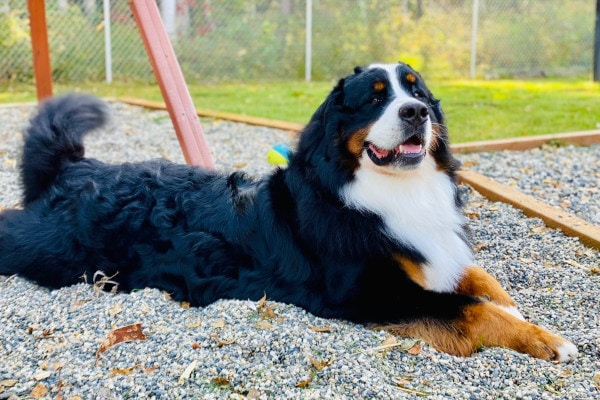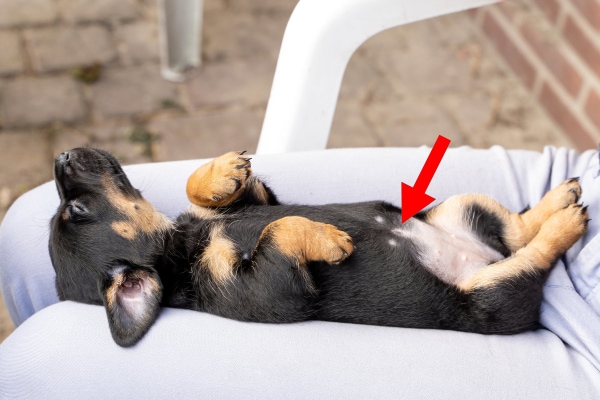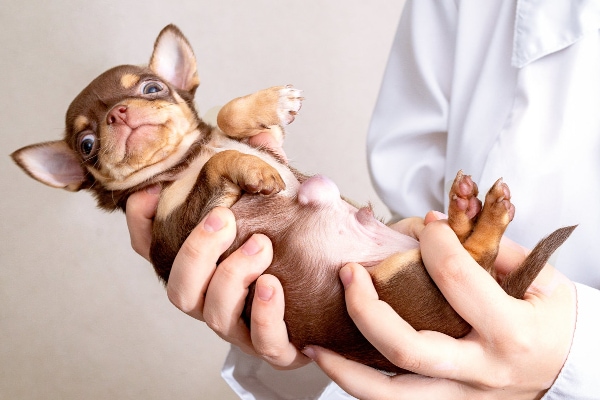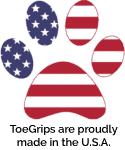Have you even wondered “Do dogs have belly buttons?” while giving your dog a tummy rub? As it turns out, the answer is “Yes!” Dr. Bentley Richards, friend and colleague of integrative veterinarian Dr. Julie Buzby, explains how to find your dog’s belly button, what it should look like, and how to recognize signs of any potential problems.

Whether you have a 10-pound Chihuahua (like Dr. Buzby) or a 150-pound Bernese Mountain Dog (like me), it’s probably a given that your dog asks for belly rubs when he or she is feeling happy or playful. Exposing the belly is a sign of submission and acceptance in dogs. And it can mean that they are feeling especially safe and content in your presence.
Next time you’re rubbing your dog’s belly (and saying sweet things in that funny voice that we always reserve just for them), pay attention to how that puppy tummy feels and looks. If you’re looking closely enough, you should be able to spot your pup’s belly button! You may have never considered that dogs (and cats!) have belly buttons, but they do. And knowing a little more about them and their function can prepare you to spot any abnormalities that would warrant a visit to your vet.
Yes! Dogs have belly buttons!
You may or may not remember from science class that all mammals except marsupials have belly buttons (i.e. navels). Humans, cats, rabbits, dogs, even horses and cows, have belly buttons! This is because they are placental mammals (i.e. those that use a placenta to nourish the developing fetus). Animals that are born from eggs (i.e. oviparous animals) do not have belly buttons.

The belly button is actually a small flat scar that marks the place where nutrients and oxygen were transferred from the mother’s womb (and placenta) to the fetus via the umbilical cord. After delivery, this connection is no longer needed. The umbilical cord is cut, broken, or chewed through by the mother. At this point, a short stalk remnant is attached to the puppy’s body.
If the puppies are born in a vet hospital, the vet may trim this stalk short and apply antiseptic to the end. Then he or she may tie it off with suture material close to the puppy’s body. Over the next few days, the stalk will dry up and painlessly fall off on its own. Sometimes the nursing mother then eats it (gross!). The scar left after the puppy loses the umbilical stalk is what we call the belly button or umbilicus.
Where is a dog’s belly button?
If you are looking for your dog’s belly button, it may be difficult to locate! Just like in people, belly buttons on dogs come in all shapes and sizes. They should always be on the midline of the belly, between your dog’s nipples. If your dog is particularly furry, like mine is, it can help to part the hair to either side so you can see the pale skin underneath.
You will most likely locate the belly button halfway between the base of your dog’s rib cage and the pelvis. Sometimes it will be easier to feel than it is to see. The belly button will be a fingertip-sized thickened spot, slightly raised or dipped below the skin surface. There may be a swirl of fur around it.
You will notice that dog belly buttons look and feel very different from a human’s. They will be considerably shallower and smaller—no room for belly button lint collection here! In fact, humans have one of the more prominent belly buttons in the animal kingdom. Most animals’ navels are more difficult to locate due to their discrete size and fur covering.

What should—and shouldn’t—my dog’s belly button look like?
Ideally, your dog’s belly button should look so much like the surrounding tissue that it is difficult to locate, even up close. Unless you are looking at the belly of a newborn puppy while the umbilical stump heals properly, the skin should be the same color or even a little paler than the rest of the belly skin.
However, if you notice that your dog’s skin in this region is red, dark brown, or black (i.e. any color that is not normal for your dog’s skin on the rest of the body), this can indicate problems such as:
- Inflammation
- Irritation
- Infection
- Chronic allergies (that might benefit from allergy medicine for dogs)
Examining your dog’s belly can be a very helpful way to spot the first signs of dermatitis, or inflammation of the skin. This is because the fur is less thick on the belly and the skin is easier to see. Dermatitis also often presents first on the abdomen before spreading to other areas. If you think the skin on your dog’s belly looks abnormal, please make an appointment with your vet.
Dog belly button hernias
In other cases, the skin around the belly button may appear normal, but the shape is not. If your dog’s belly button looks like an “outie” and is protruding above the skin surface like a knot or lump, it may be an umbilical hernia in dogs. A hernia occurs when the muscle layers under the skin develop a tear or window.
Sometimes hernias are present from birth due to the way that the fetus developed in utero. They can also occur later in life due to trauma. With a hernia, the skin is still holding the intestines (or other abdominal contents) inside the body. However, loops of bowel can poke through the muscle layer and become entrapped, cutting off their circulation. This is a surgical emergency.

If your dog has an “outie” belly button (which might actually be an umbilical hernia with or without trapped intestines), please get him or her evaluated by your vet as soon as possible. It is always best to promptly consult your vet about a dog belly button lump.
A belly rub plus a belly button evaluation
If you were to ask your dog how often he or she needs a belly button check, the answer would probably be “Ten times per day!” just to get the extra tummy rubs. However, being mindful of the anatomy and appearance of your dog’s belly button whenever you pet him or her is probably sufficient for monitoring purposes.
You can also add this into your routine tip-to-tail dog health and wellness scan. Any time you notice a change in your dog, be sure to ask your vet if treatment is required.
Has your dog had any belly button problems?
Please comment below.


We welcome your comments and questions about senior dog care.
However, if you need medical advice, diagnosis, or treatment, please contact your local veterinarian.